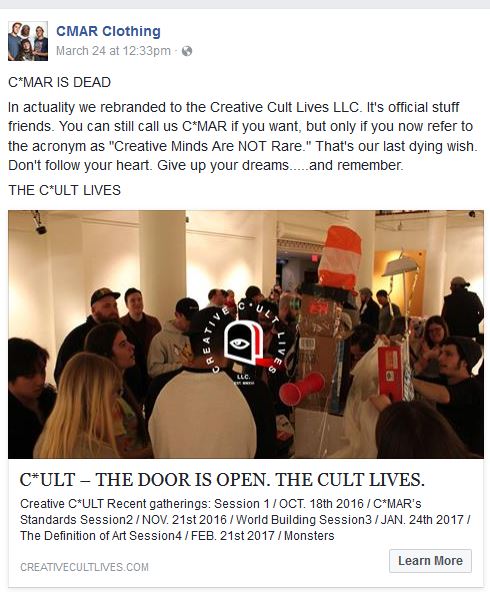Do you have a few moments so I can share some information about a cult I joined?
No, wait, wait, before you run away. This is not that type of cult. In fact, this cult demands much less in the way of slavish devotion than most arts people willingly surrender to the groups they work with.
This cult emerged from the process we all idealize when we envision the result of arts education. You can read the origin story on their website, but I wanted to give my take on it.
Four guys took a class on the creative process and were so inspired by the teacher, they looked for a way to extend what they learned after the class ended. They started rooming together. They had a couple art shows of their own and entered those sponsored by others. They started a lifestyle clothing line called C*MAR which stood for Creative Minds Are Rare.
I liked their ambition and energy so at a point between their first and second art show, I approached them about helping to launch and promote a semi-annual “After Dark” art event to showcase the talent of the visual artists in the community.
Then they started a cult.
The Creative Cult to be exact. They decided they wanted to teach others the creative process. On a monthly basis, they began holding hourly events in different places around town getting the 40-50 attendees to engage in and talk about the creative process.
I have mentioned some of these events before. There are images from each of the events on their website. Don’t feel obligated to look too closely for me.
As with all cults, there was an obligatory bloody sacrifice. In this case, the guys killed off their identity as C*MAR. They realized the activities of the creative cult and their ambitions for it had eclipsed that of the lifestyle clothing company.
Also, after some conversations, they realized the name Creative Minds Are Rare is entirely contrary to their heartfelt mission, “We teach people our creative process, so that artists and ‘non-artists’ alike may develop their own.”
Now they are in talks to start Creative Cult chapters in other places. I tell them that at this point in their development, any self-respecting cult would have robes and kool-aid, but to no avail. There was a cult meeting in a candle-lit damp basement so I can hope.
I often talk about the movement to Build Public Will For Arts and Culture (so much so, you probably assumed that was the cult I joined). I really see these guys achieving this naturally by instinct whereas so many other arts entities will have to work to shift their approaches and mindset.
Which is not to say the organizers don’t work hard putting these events together and trying to learn more about the creative process. I send them literature that impresses me and they send some back. I know a couple of them are in the daily habit of creating for a few hours every morning outside of their regular work. They show up at poetry readings around town to get feedback.
My organization partnered with two other organizations to conduct an “arts listening tour” in the community and at least one of the cult organizers was at every session taking notes about people’s perceptions of the arts and culture opportunities in the area. They are committed to always doing a better job.
Yesterday I wrote about how it would be a mistake for other classical musicians to try to emulate pianist Alpin Hong’s personality in order to connect with audiences. I would say the same thing about the “inner circle” of the cult.
As young guys, they have a certain cachet with exactly the target demographic most arts organizations want to reach. It would be a disaster of comedic proportions if most of the established arts organizations in the area tried to adopt their approach. However, I think we all ultimately benefit from the work they do because it potentially opens people up to the idea of participating in other activities in town.
In turn, I have been talking them up in the circles in which I travel on the local, state, regional and national level. While we can’t replicate the exact dynamics of the Creative Cult’s relationship with each other, it is still a good example of the type of things that can be done.



Thanks for what you are doing to bring cultural change to the arts. It is so important to represent everyone.…